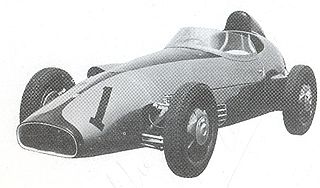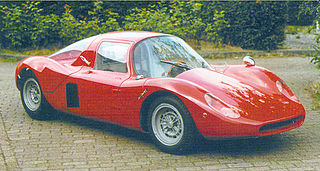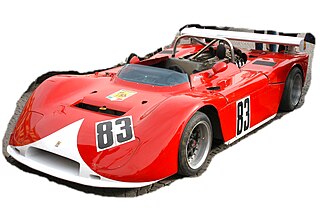

The Bandini 1100, introduced in 1946 by Ilario Bandini, was the first car to wear the Bandini badge. A similar model with the same name was produced afterwards from 1947-1950.


The Bandini 1100, introduced in 1946 by Ilario Bandini, was the first car to wear the Bandini badge. A similar model with the same name was produced afterwards from 1947-1950.

The Fiat steel frame was modified to carry independent suspension with front torsion bar. At the rear, hydraulic drum brakes were placed next to the differential, attached to a frame also fitted with elastic suspension elements borrowed from a Gilera motorcycle, shock absorbers and a clutch system articulation lever adapted from a door closing device salvaged from a local pub.

The aluminium bodywork was done by Rocco Motto. It was a one-piece two-seater with an elegant, sinuous, sporting shape. The large center-mounted grille was made up of seventeen vertical bars, and was flanked by large headlights. The streamlined broad front defines the lines that drop to the rear wheels affecting even the doors. Instead of a fixed windshield, Bandini chose to fit two "slides". The rear wheels are particularly pronounced, while the rear is low and tapered. The wheels are Borrani wires.
The engine is the original Fiat 1100, tuned by Bandini.

The Fiat 128 is a transverse front-engine, front wheel drive small family car manufactured and marketed by Fiat from 1969 to 1985 as a two- or four-door sedan, three- or five-door station wagon as well as two- or three-door coupé. The 128 running gear and engine, reconfigured for a mid-engined layout, were used in the Fiat X1/9 sports car.

PTV was a trademark of Automóviles Utilitarios S. A. a microcar manufacturer based in Manresa, near Barcelona, Spain. The PTV brand was at one time the second biggest volume microcar sold in Spain, beaten only by the Biscúter. Compared to the Biscúter it was more luxurious, offering proper doors, two-tone paint, chrome trim and 12 inch wheels.
Bandini Automobili was an Italian automobile manufacturer operating between 1946 and 1992. It was named after its founder Ilario Bandini.

Ilario Bandini was an Italian businessman, racing driver, and racing car manufacturer.

The Bandini 1100 is a car model produced from 1947 until 1950 by the Italian company Bandini Cars. It was the successor to the early 1946 model. A racing version was produced under the name Bandini 1100 siluro.

The Bandini 1100 Siluro is a racing car produced from 1947 to 1949 by Bandini Automobili in Forlì, Italy.

The Bandini-Maserati 1500 is a racing car, produced in 1953 by Bandini Automobili.

The Bandini 750 sport siluro (torpedo) is a racing car, produced from 1950 to 1956 by the Italian company Bandini Cars.

The Bandini 750 international sport also called simply "Saponetta", is a racing car built from 1957 until 1961 by Bandini Cars.

The Bandini formula junior is a racing car produced from 1959 to 1962 by the Bandini Automobili company of Forlì, Italy.

The Bandini GT 750 is a road car produced in 1955 by Bandini Cars in their Forlì factory. Although used for racing it was intended as a road car and used the chassis from the single seat 750 sport siluro with a tuned 747 cc 4-cylinder engine.

The Bandini 1000 GT is a road car produced in 1963 by Bandini Cars of Forlì, Italy.

The Bandini Saloncino is a racing car, built in 1968 by Bandini Automobili in Forlì, Italy.

The Bandini 1000 turbo, also known as Bandini Berlinetta is a hand-built road car, built in 1992 by engineer Ilario Bandini. The Berlinetta was his last design and represents the ultimate evolutionary step of his long career.

The Bandini 1000 P is a race car, built from 1959 until 1965 by Bandini Cars Forlì as a Prototype for future Formula Junior racing cars.

The Bandini 1000 is a race car, built in 1966 by Bandini Cars Forlì.

The Bandini 1000 V sports prototype is a race car built in 1970 by Bandini Cars Forlì.

The Bandini 1000 sports prototype is an Italian racing car built in 1972 by Bandini Cars.

The Bandini 1300 was a racing car built in 1980 by Bandini Cars in Forlì, Italy.

The Fiat 1100 is a small family car produced from 1937 to 1953 by the Italian car manufacturer Fiat. It was introduced in 1937 as Fiat 508 C or Balilla 1100, as a replacement for the Fiat 508 Balilla. Under the new body the 508 C had more modern and refined mechanicals compared to the 508, including independent front suspension and an enlarged overhead valve engine. In 1939 it was updated and renamed simply Fiat 1100. The 1100 was produced in three consecutive series—1100, 1100 B and 1100 E—until 1953, when it was replaced by the all-new, unibody Fiat 1100/103.